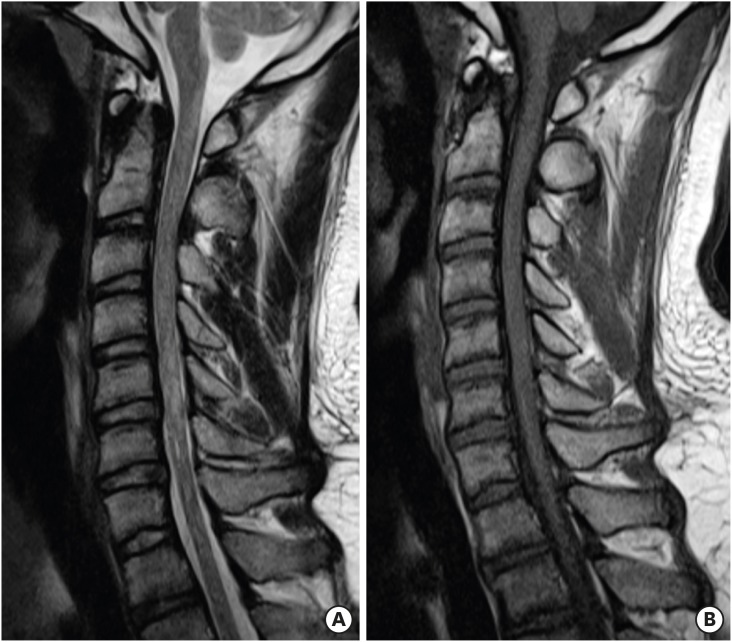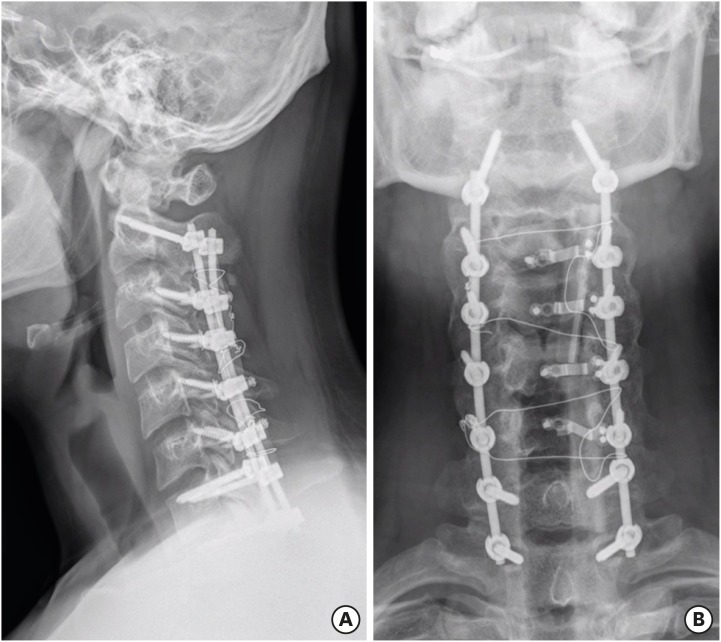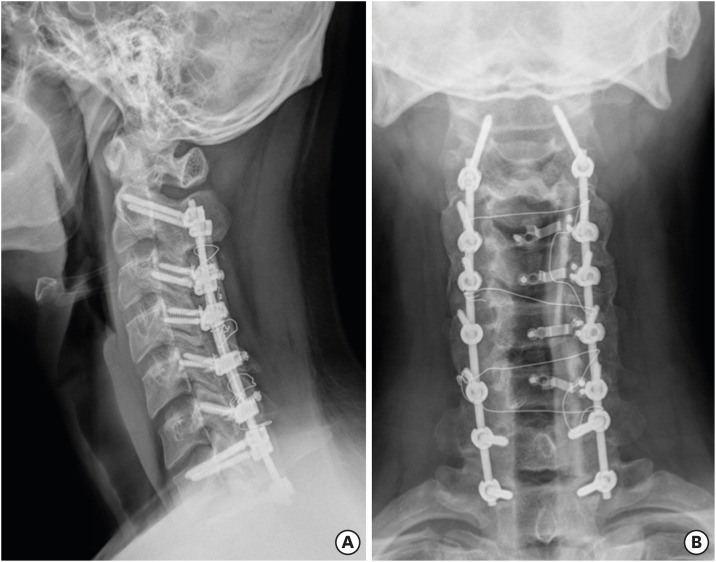Korean J Neurotrauma.
2019 Oct;15(2):199-203. 10.13004/kjnt.2019.15.e24.
Progressive Cervical Spondylotic Myelopathy Caused by Tic Disorders in a Young Adult with Tourette Syndrome
- Affiliations
-
- 1Department of Neurosurgery, Gyeongsang National University School of Medicine, Jinju, Korea. leeys1026@hanmail.net
- 2Department of Anesthesiology and Pain Medicine, Gyeongsang National University School of Medicine, Jinju, Korea.
- KMID: 2461128
- DOI: http://doi.org/10.13004/kjnt.2019.15.e24
Abstract
- Involuntary movement of the cervical spine can cause damage to the cervical spinal cord. Cervical myelopathy may occur at an early age in involuntary movement disorders, such as tics. We report the case of a 21-year-old man with Tourette syndrome, who developed progressive quadriparesis, which was more severe in the upper extremities. The patient had abnormal motor tics with hyperflexion and hyperextension of the cervical spine for more than 10 years. High-signal intensity intramedullary lesions were observed at C3-4-5-6 level on T2 weighted magnetic resonance imaging. Examinations were performed for high-signal intensity intramedullary lesions that may occur at a young age, but no other diseases were detected. Botulinum toxin injection to the neck musculature and medication for tic disorders were administered. However, the myelopathy was further aggravated, as the involuntary cervical movement still remained. Therefore, laminoplasty was performed at C3-4-5-6, with posterior fixation at C2-3-4-5-6-7 to alleviate the symptoms. The neurological signs and symptoms improved dramatically. The management of tic disorders should be the first priority during treatment. However, surgical treatment may be necessary, if symptoms worsen after appropriate treatment.
MeSH Terms
Figure
Reference
-
1. Adler CH, Zimmerman RS, Lyons MK, Simeone F, Brin MF. Perioperative use of botulinum toxin for movement disorder-induced cervical spine disease. Mov Disord. 1996; 11:79–81. PMID: 8771071.
Article2. Aguirregomozcorta M, Pagonabarraga J, Diaz-Manera J, Pascual-Sedano B, Gironell A, Kulisevsky J. Efficacy of botulinum toxin in severe Tourette syndrome with dystonic tics involving the neck. Parkinsonism Relat Disord. 2008; 14:443–445. PMID: 18337152.
Article3. Bloch MH, Leckman JF. Clinical course of Tourette syndrome. J Psychosom Res. 2009; 67:497–501. PMID: 19913654.
Article4. Dobbs M, Berger JR. Cervical myelopathy secondary to violent tics of Tourette's syndrome. Neurology. 2003; 60:1862–1863. PMID: 12796554.
Article5. Eddy CM, Rickards HE, Cavanna AE. Treatment strategies for tics in Tourette syndrome. Ther Adv Neurol Disorder. 2011; 4:25–45.
Article6. Isaacs JD, Adams M, Lees AJ. Noncompressive myelopathy associated with violent axial tics of Tourette syndrome. Neurology. 2010; 74:697–698. PMID: 20177125.
Article7. Ko DY, Kim SK, Chae JH, Wang KC, Phi JH. Cervical spondylotic myelopathy caused by violent motor tics in a child with Tourette syndrome. Childs Nerv Syst. 2013; 29:317–321. PMID: 23053364.
Article8. Krauss JK, Jankovic J. Severe motor tics causing cervical myelopathy in Tourette's syndrome. Mov Disord. 1996; 11:563–566. PMID: 8866498.
Article
- Full Text Links
- Actions
-
Cited
- CITED
-
- Close
- Share
- Similar articles
-
- Cervical Spinal Fracture Caused by Untreated Tourette Syndrome: A Case Report
- Beliefs about Tic Disorders and Tourette's Syndrome in South Korea: An Online Panel Survey
- Psychotrophic Drug Therapy of the Tourette's Disorder
- Non-Psychopharmacologic Therapy of Tic or Tourette's Disorder
- Environmental Risk Factors in Tic Disorders




